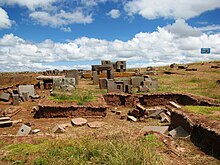 View at the ruins of Pumapunku | |
| Alternative name | Puma Punku |
|---|---|
| Location | Western Bolivia |
| Altitude | 3,850 m (12,631 ft) |
| Type | platform mound |
| Part of | Tiwanaku Site |
| Length | 116.7 metres |
| Width | 167.4 metres |
| Area | at least 14 hectares |
| History | |
| Material | sifted and layered soils (mound), andesite (superstructure), sandstone (foundation and internal channels), ternary Cu–As–Ni bronze alloy (cramps), mortar of lime and sand with ground-up malachite (turquoise green plaster floor), clay (red floor) |
| Founded | 536–600 |
| Cultures | Tiwanaku empire |
| Site notes | |
| Discovered | 1549 by Pedro Cieza de León (first European visitor) |
| Excavation dates | Alexei Vranich |
| Condition | Ruined |
| Architecture | |
| Architectural styles | Pumapunku Style architecture |
16°33′42″S 68°40′48″W / 16.56169°S 68.67993°W

Pumapunku or Puma Punku (Aymara and Quechua 'Gate of the Puma') is a 6th-century T-shaped and strategically aligned man-made terraced platform mound with a sunken court and monumental structure on top. It is part of the Pumapunku complex, at the Tiwanaku Site near Tiwanacu, in western Bolivia. The Pumapunku complex is a collection of plazas and ramps centered on the Pumapunku platform mound. Today only the ruins of the monumental complex on top of the Puma Punku platform mound remain.
Construction of Puma Punku is believed to have begun after AD 536. Pumapunku was the most important construction in Tiwanaku, other than Akapana, which is believed to be "Pumapunku's twin". Among the place names in Tiwanaku, only the names "Akapana" and "Pumapunku" have historical relevance.
Pumapunku holds several miniature gates that are perfect replicas of once standing full-size gateways. In addition to these miniature gateways, likely, at least five gateways (and several blind miniature gateways) were once (or were intended to be) integrated into the Pumapunku monumental complex. The foundation platform of Pumapunku supported as many as eight andesite gateways. The fragments of five andesite gateways with similar characteristics to the Gateway of the Sun were found.
Tiwanaku, the location of Pumapunku, is significant in Inca traditions. According to traditions, Tiwanaku is believed to be the site where the world was created.[1]
The Pumapunku complex consists of an unwalled western court, a central unwalled esplanade, a terraced platform mound that is faced with stone, and a walled eastern court.[2][3][4]
At its peak, Pumapunku is thought to have been "unimaginably wondrous,"[3] adorned with polished metal plaques, brightly colored ceramic and fabric ornamentation, and visited by costumed citizens, elaborately dressed priests, and elites decked in exotic jewelry. Current understanding of this complex is limited due to its age, the lack of a written record, and the current deteriorated state of the structures due to treasure hunting, looting, stone mining for building stone and railroad ballast, and natural weathering.[2][3][5]
- ^ Birx, H. James (2006). Encyclopedia of Anthropology. Thousand Oaks, CA: Sage Publications, Inc. doi:10.4135/9781412952453. ISBN 9780761930297.
- ^ a b Isbell 2004.
- ^ a b c Vranich 1999.
- ^ Vranich 2006.
- ^ Sanginés 1970.